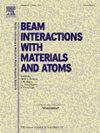高斯质子束在水中三维剂量沉积的近似解析公式
IF 1.4
3区 物理与天体物理
Q3 INSTRUMENTS & INSTRUMENTATION
Nuclear Instruments & Methods in Physics Research Section B-beam Interactions With Materials and Atoms
Pub Date : 2025-02-27
DOI:10.1016/j.nimb.2025.165653
引用次数: 0
摘要
一个名为TOP-IMPLART的质子直线加速器,作为质子治疗全直线机器的原型而开发,目前正在意大利弗拉斯卡蒂研究中心的ENEA实验室中运行。为了预测体积的测试辐照,或者更具体地说,模拟处理计划来检查直线加速器的性能,需要有一个流线型的工具来计算三维空间中的剂量沉积和设计体积展开的布拉格峰。为此目的,一个初步的快速的三维剂量计算方法,避免冗长的蒙特卡罗模拟将是非常方便的。本文推导了高斯质子束在水中沉积剂量体积的近似计算公式。该公式结合了波特菲尔德的布拉格曲线模型和普雷斯顿-科勒的铅笔梁加宽模型。给出了示例测试。本文章由计算机程序翻译,如有差异,请以英文原文为准。
An approximate analytical formula for 3D dose deposition in water by a Gaussian proton beam
A proton linear accelerator named TOP-IMPLART, developed as a prototype of a full linear machine for proton therapy, is currently in operation at the ENEA laboratories of the Frascati Research Center in Italy. In anticipation of test irradiations of volumes or, more specifically, simulated treatment plans to check the linac’s performance, it is desirable to have a streamlined tool for calculating dose deposition in three spatial dimensions and for designing volumetric spread-out Bragg peaks. To this end, a preliminary quick approach to 3D dose calculation that avoids lengthy Monte Carlo simulations would be quite convenient. Here, we present the derivation of an analytical formula for the approximate calculation of the dose volume deposited in water by a Gaussian proton beam. The formula combines Bortfeld’s Bragg curve model with Preston–Koehler’s model for the widening of pencil beams. Example tests are shown.
求助全文
通过发布文献求助,成功后即可免费获取论文全文。
去求助
来源期刊
CiteScore
2.80
自引率
7.70%
发文量
231
审稿时长
1.9 months
期刊介绍:
Section B of Nuclear Instruments and Methods in Physics Research covers all aspects of the interaction of energetic beams with atoms, molecules and aggregate forms of matter. This includes ion beam analysis and ion beam modification of materials as well as basic data of importance for these studies. Topics of general interest include: atomic collisions in solids, particle channelling, all aspects of collision cascades, the modification of materials by energetic beams, ion implantation, irradiation - induced changes in materials, the physics and chemistry of beam interactions and the analysis of materials by all forms of energetic radiation. Modification by ion, laser and electron beams for the study of electronic materials, metals, ceramics, insulators, polymers and other important and new materials systems are included. Related studies, such as the application of ion beam analysis to biological, archaeological and geological samples as well as applications to solve problems in planetary science are also welcome. Energetic beams of interest include atomic and molecular ions, neutrons, positrons and muons, plasmas directed at surfaces, electron and photon beams, including laser treated surfaces and studies of solids by photon radiation from rotating anodes, synchrotrons, etc. In addition, the interaction between various forms of radiation and radiation-induced deposition processes are relevant.

 求助内容:
求助内容: 应助结果提醒方式:
应助结果提醒方式:


